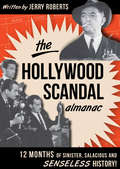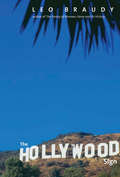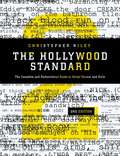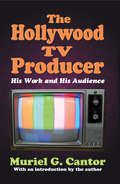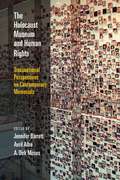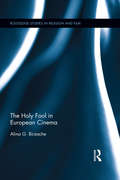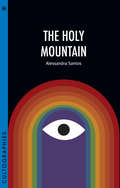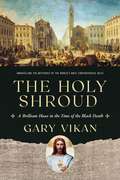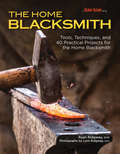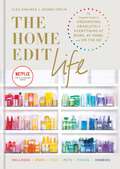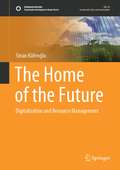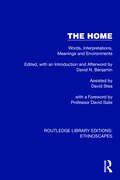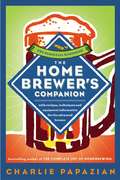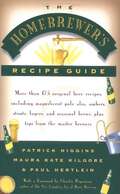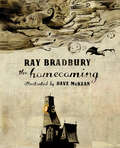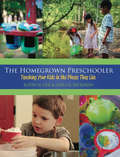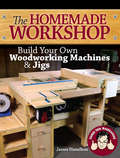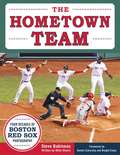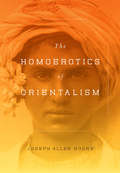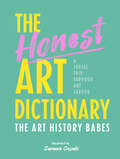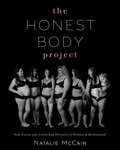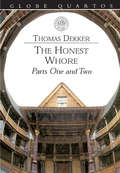- Table View
- List View
The Hollywood Scandal Almanac: 12 Months of Sinister, Salacious and Senseless History!
by Jerry RobertsA &“this day in Hollywood history&” reference that recounts the scandals of the stars—from Charlie Chaplin to Charlie Sheen. The real-life scandals of Hollywood&’s personalities rival any drama they bring to life on the silver screen. This book provides 365 daily doses of high and low crimes, fraud and deceit, culled from Tinseltown&’s checkered past. Whether it&’s the exploits of silent-era star Fatty Arbuckle, the midcentury misdeeds of Frank Sinatra and Marilyn Monroe, or the modern excesses of Lindsay Lohan, this calendar of Hollywood transgressions has a sensational true tale for every day of the year. It&’s an entertaining and sometimes shocking trip down memory lane filled with sneaky affairs, box-office bombs, and careers cut short—sometimes by murder. It shows that the drama doesn&’t end when the credits roll.
The Hollywood Sign: Fantasy And Reality Of An American Icon (Icons of America)
by Leo BraudyThe story behind the massive white block letters set into a steep Los Angeles hillside—and the city and culture they represent: &“Terrific.&”—San Francisco Chronicle To so many who see its image, the Hollywood sign represents the earthly home of that otherwise ethereal world of fame, stardom, celebrity—the American and worldwide aspiration to be in the limelight, to be, like the Hollywood sign itself, instantly recognizable. How an advertisement erected in 1923, touting the real estate development Hollywoodland, took on a life of its own is a story worthy of a movie itself. Leo Braudy traces the remarkable life of this distinctly American landmark, which has been saved over the years by a various fans and supporters, among them Alice Cooper and Hugh Hefner, who spearheaded its reconstruction in the 1970s. He also uses the sign&’s history to offer an intriguing look at the rise of the film business from its earliest, silent days through the development of the studio system that helped define modern Hollywood. Mixing social history, urban studies, literature, and film, along with forays into such topics as the lure of Hollywood for utopian communities and the development of domestic architecture in Los Angeles, The Hollywood Sign is a fascinating account of how a temporary structure has become a permanent icon of American culture. &“An entertaining tale.&”—The Washington Post
The Hollywood Standard: The Complete and Authoritative Guide to Script Format and Style (2nd edition)
by Christopher Riley"The Hollywood Standard" describes, in clear, vivid prose and hundreds of examples, how to format every element of a screenplay or television script. A reference for everyone who writes for the screen, from the novice to the veteran, this is the dictionary of script format, with instructions for formatting everything from the simplest master scene heading to the most complex and challenging musical underwater dream sequence. This new edition includes a quick start guide, plus new chapters on avoiding a dozen deadly formatting mistakes, clarifying the difference between a spec script and production script, and mastering the vital art of proofreading. For the first time, readers will find instructions for formatting instant messages, text messages, email exchanges and caller ID.
The Hollywood Studios: House Style In The Golden Age Of The Movies
by Ethan MorddenHollywood in the years between 1929 and 1948 was a town of moviemaking empires. The great studios were estates of talent: sprawling, dense, diverse. It was the Golden Age of the Movies, and each studio made its distinctive contribution. But how did the studios, "growing up" in the same time and place, develop so differently? What combinations of talents and temperaments gave them their signature styles? These are the questions Ethan Mordden answers, with breezy erudition and irrepressible enthusiasm, in this fascinating and wonderfully readable book. Mordden illuminates how the style of each studio was primarily dictated by the personality, philosophy, and attitudes of its presiding mogul-and how all these factors affected the work and careers of individual actors, directors, writers, and technicians, and the success of the studio in general.
The Hollywood TV Producer: His Work and His Audience
by Muriel G. CantorExcept for accounts of journalists, dissident employees, and an occasional congressional committee focusing on crime and unethical practices, we have known very little about how television programs are produced. The Hollywood TV Producer, originally published in 1971, was the first serious examination of constraints, conflicts, and rewards in the daily lives of television producers. Its insights were important at the time and have not been challenged.Using as her framework the social system of mass communications, Muriel G. Cantor shows how producers select stories for television series and how movies end up in prime time. In order to get a comprehensive look at the inner workings of the TV industry and its producers, the author interviewed eighty producers in Hollywood over a two-season period. She probed to discover how the people producers work for and where they work influences their decision-making.As Cantor shows, critics of television who suggest that to remain in production, a producer must first please the business organization that finances his or her operations, are largely correct. Cantor shows that content is determined by a combination of artistic and professional factors, as well as social, economic, and political norms that have developed over time in the industry.
The Holocaust Museum and Human Rights: Transnational Perspectives on Contemporary Memorials (Pennsylvania Studies in Human Rights)
by American PhilosoInterrogates the global, and often controversial, phenomenon of Holocaust and human rights museumsSpanning six continents—Europe, Australia, Africa, Asia, North America, and South America—this edited collection offers a comparative, transnational study of Holocaust and human rights museums that foregrounds the overlapping and often contested work these institutions do in narrating and memorializing histories of genocide and human rights abuses for a public audience. Museums that link the Holocaust with social justice, human rights, and genocide prevention have been founded in many countries—for example, the Kazerne Dossin Memorial Museum in Belgium, the Anne Frank House in the Netherlands, and the Johannesburg Holocaust and Genocide Centre in South Africa—making Holocaust and human rights museums a global phenomenon. It is not uncommon for these institutions to court controversy by linking the Holocaust to human rights issues in their locales and abroad. Some begin from a “Holocaust core” and extrapolate from this history to address broader concerns, while others integrate the Holocaust as “a” or, at times, “the” case study par excellence of human rights abuses. Other institutions that may not explicitly focus on the Holocaust continue to engage these representational practices to highlight other instances of genocide and human rights abuses.The case studies in this book illuminate the convergences between Holocaust and human rights museums in their demands for social justice and reparation, educational and activist purpose, design principles, and curatorial choices. But it also shows how these museums can also be sites of contestation around how stories of suffering, courage, and survival are told; whose stories are prioritized; and who is consulted. Although Holocaust museums were once the most influential form of representation of human rights issues in the international museum and heritage fields, they are now in dialogue—visually, spatially, methodologically—with museums and memorial sites concerned with human rights more broadly. Interrogating debates in both museology and Holocaust memory studies, this volume reveals how institutions dedicated to these concerns have become active and influential contributors to local, national, and transnational dialogues about human rights.Contributors: Avril Alba, Brook Andrew, Jennifer Barrett, Jennifer Carter, Danielle Celermajer, Steven Cooke, Donna-Lee Frieze, Shirli Gilbert, Sulamith Graefenstein, Christoph Hanzig, Vannessa Hearman, Rosanne Kennedy, Marcia Langton, Edwina Light, Wendy Lipworth, A. Dirk Moses, Tali Nates, Jessica Neath, Michael Robertson, Amy Sodaro, Garry Walter.
The Holocaust in Czechoslovak and Czech Feature Films (Literatur Und Kultur Im Mittleren Und Östlichen Europa Ser. #19)
by Šárka SladovníkováŠárka Sladovníková analyzes the depiction of the Holocaust in Czechoslovak and Czech feature films and the relevant literary pretexts. While she charts the social and cultural framework in which the films were made and how this framework changed, she also focuses on the cinematic language, the composition of and narration in each film (e.g., the depiction of the war and the Shoah as a narratively closed versus a narratively open event), genre aspects of the films (e.g., the use of comedy and humor), and convention and innovation in presenting motifs and characters (the division of gender roles, the character of the “good German”). Particular attention is paid to the portrayal of stereotypes and countertypes in the films, where already well-known images, situations, and backdrops are repeated and which meet viewers’ expectations or, in contrast, which form countertypes and countersituations that go against the grain. Many of the films analyzed are adaptations of literary works. Therefore, this book is also a contribution to the rapidly developing field of adaptation studies.
The Holy Fool in European Cinema (Routledge Studies in Religion and Film)
by Alina G. BirzacheThis monograph explores the way that the profile and the critical functions of the holy fool have developed in European cinema, allowing this traditional figure to capture the imagination of new generations in an age of religious pluralism and secularization. Alina Birzache traces the cultural origins of the figure of the holy fool across a variety of European traditions. In so doing, she examines the critical functions of the holy fool as well as how filmmakers have used the figure to respond to and critique aspects of the modern world. Using a comparative approach, this study for the first time offers a comprehensive explanation of the enduring appeal of this protean and fascinating cinematic character. Birzache examines the trope of holy foolishness in Soviet and post-Soviet cinema, French cinema, and Danish cinema, corresponding broadly to and permitting analysis of the three main orientations in European Christianity: Orthodox, Catholic, and Protestant. This study will be of keen interest to scholars of religion and film, European cinema, and comparative religion.
The Holy Mountain (Cultographies)
by Alessandra SantosAlejandro Jodorowsky's El Topo helped inaugurate the midnight movie phenomenon. Its success spawned The Holy Mountain, through interventions by John Lennon and Allen Klein. After a scandalous release and a 16-month midnight career, The Holy Mountain was relegated to the underground world of fan bootlegs for over thirty years until its limited restored release in 2007. This short study reveals how The Holy Mountain, a poetic, hilarious, and anarchist cult film by an international auteur, anchored in post-1968 critiques, is – at the same time – an archaeological capsule of the counterculture movement, a timely subversion of mystical tenets, and one of the most mysterious films in the history of world cinema.
The Holy Shroud: A Brilliant Hoax in the Time of the Black Death
by Gary VikanA towering figure in the art world unravels the mystery of the world&’s most controversial relic.The history of the Christian church is strewn with holy relics and artifacts, none more controversial than the Shroud of Turin, the supposed burial cloth of Christ. In The Holy Shroud Gary Vikan shows that the shroud is not the burial cloth of Jesus, but rather a photograph-like body print of a medieval Frenchman created by a brilliant artist serving the royal court in the time of the Black Death. It was gifted by King John II to his friend Geoffroi de Charny, the most renowned knight of the Middle Ages, who shortly thereafter died at the disastrous Battle of Poitiers while saving the King&’s life. Though intended as nothing more than an innocuous devotional image for Geoffroi&’s newly-built church in the French hamlet of Lirey, it was soon misrepresented. Miracles were faked, money was made.Combining copious research and decades of art world experience with an accessible, wry voice, Gary Vikan shows how one of the greatest hoaxes in the history of Christian relics came into being.
The Home Blacksmith: Tools, Techniques, and 40 Practical Projects for the Blacksmith Hobbyist
by Ryan RidgwayAs more and more people join the do-it-yourself revolution, they are breathing new life into many time-honored skills and crafts. Blacksmithing is among the trades that are enjoying a resurgence for both practical and artistic uses, yet there is not an abundance of readily accessible information available to beginning blacksmiths to help them get started and understand the craft. Author Ryan Ridgway, a veterinarian and blacksmith with more than fifteen years of metalworking experience, hopes to fill that void with this comprehensive volume geared toward answering the many questions that new blacksmiths often have. By explaining the physics of moving metal, the different styles of anvils and forges, and alternative fuel sources, Ridgway sets his book apart from less detailed volumes. Forty practical, easy-to-follow projects are presented, showing aspiring blacksmiths how to make tools, such as hammers and chisels; farm implements, such as gate latches and hoof picks; and items for home use, including drawer pulls and candle holders.Inside The Home Blacksmith:The evolution of blacksmithing around the world and the differences between the tools specific to each regionThe behavior of heated metal and the science of metalworkingSetting up a shop safely and economicallyThe heart of your shop-the anvil and forge-and the other essential toolsWorking with different types of steel, including how to salvage steel for different usesTechniques from beginning to advancedStep-by-step instructions for forty blacksmithing projects: tools and other implements as well as decorative pieces for personal use or sale
The Home Edit Life: The Complete Guide to Organizing Absolutely Everything at Work, at Home and On the Go (Home Edit)
by Clea Shearer Joanna TeplinThe New York Times Number One BestsellerA Netflix Original Series.'Move over, Marie Kondo - Clea Shearer and Joanna Teplin are the professional organisers the A-list now let rifle through their drawers.' - Sunday Times StyleClea Shearer and Joanna Teplin are back again to bring both function and beauty to your everyday life. In The Home Edit Life they show you how to contain the chaos when it comes to absolutely everything: your work, travel, kids, pets and more. Because the truth is, you don't have to live like a minimalist to feel happy and calm.The Home Edit mentality is all about embracing your life, whether you're a busy mum, a jetsetter - or both! You simply need to know how to set up a system that works for you so you'll maintain it for the long run. Get to know your organizing style, learn how to tailor it to your habits and, best of all, leave the guilt behind when it comes to owning things. With The Home Edit Life, you'll be corralling cords, archiving photos, packing your suitcase like a pro, and arranging your phone apps by colour in no time.'While the Nashville-based founders of The Home Edit (and its celeb-followed Instagram) may not be able to give you Rachel Zoe's enviable shoe collection, they can give you the tools to get your own into similarly immaculate order - and hey, that's a step in the right direction.' - People
The Home Edit Life: The Complete Guide to Organizing Absolutely Everything at Work, at Home and On the Go, A Netflix Original Series – Season 2 now showing on Netflix (Home Edit)
by Clea Shearer Joanna TeplinThe New York Times Number One BestsellerA Netflix Original Series.'Move over, Marie Kondo - Clea Shearer and Joanna Teplin are the professional organisers the A-list now let rifle through their drawers.' - Sunday Times StyleClea Shearer and Joanna Teplin are back again to bring both function and beauty to your everyday life. In The Home Edit Life they show you how to contain the chaos when it comes to absolutely everything: your work, travel, kids, pets and more. Because the truth is, you don't have to live like a minimalist to feel happy and calm.The Home Edit mentality is all about embracing your life, whether you're a busy mum, a jetsetter - or both! You simply need to know how to set up a system that works for you so you'll maintain it for the long run. Get to know your organizing style, learn how to tailor it to your habits and, best of all, leave the guilt behind when it comes to owning things. With The Home Edit Life, you'll be corralling cords, archiving photos, packing your suitcase like a pro, and arranging your phone apps by colour in no time.'While the Nashville-based founders of The Home Edit (and its celeb-followed Instagram) may not be able to give you Rachel Zoe's enviable shoe collection, they can give you the tools to get your own into similarly immaculate order - and hey, that's a step in the right direction.' - People (p) 2020 Octopus Publishing Group
The Home of the Future: Digitalization and Resource Management (Sustainable Development Goals Series)
by Sinan KüfeoğluThis book presents an in-depth study to show that a sustainable future urban life is possible. To build a safer and more sustainable future, as humankind, we would like to use more renewable energy, increase energy efficiency, reduce our carbon and water footprints in all economic sectors. The increasing population and humans’ ever-increasing demand for consumption pose another question whether the world’s resources are sufficient for present and future generations. Fair access to water, energy, and food is the objective for all. In line with the United Nations Sustainable Development Goals, scientists, researchers, engineers, and policymakers worldwide are working hard to achieve these objectives. To answer all these challenges, we would like to introduce the core of Smart Cities of the future, the building block of the future’s urban life: Open Digital Innovation Hub (ODIH). ODIH will serve as the ‘Home of the Future’, a fully digitalised and smart, self-sustaining building that answers all the motivation we highlight here. In ODIH, we introduce a living space that produces its water, energy, and food by minimising carbon and water footprints thanks to the Internet of Things, Artificial Intelligence, and Blockchain technologies. It will also serve as an open innovation environment for start-ups and entrepreneurs who wish to integrate their solutions into the infrastructure of ODIH and test those in real-time. We believe this will be a true open innovation test-bed for new business models.
The Home: Words, Interpretations, Meanings and Environments (Routledge Library Editions: Ethnoscapes)
by David Stea David N. Benjamin David SaileOriginally published in 1995, as part of the Ethnoscapes: Current Challenges in the Environmental Social Sciences series, reissued now with a new series introduction, The Home: Words, Interpretations, Meanings and Environments, written by by leading theorists and empirical researchers offers an interdisciplinary and multi-cultural spectrum of viewpoints on the study of the home concept. Among the disciplines covered are environment-behaviour research, anthropology, geography, archaeology, architecture, political science, and linguistics-place name research.The authors in this volume focus on refining our concepts of home, our knowledge of the uses of home, and the relationship of home to the study of cultural interpretation. In so doing, they inspire our thinking on the following themes: the struggle to maintain cultural continuity in the face of socio-political change, and the attempts to humanize the present and future built environment.This volume will be interesting to all scholars of cultural interpretation, geographers, and architects, and at the same time useful in graduate studies courses in environmental social sciences and environmental design as reference and source of cutting-edge case studies.
The Homebrewer's Companion
by Charles PapazianMore great advice from Charlie Papazian, homebrew master and author of the bestselling The Complete Joy of Homebrewing. "Many ask me, 'What's different about The Homebrewer's Companion?' It's a book that I might have titled The Complete Joy of Homebrewing, Volume 2. The information is 98 percent new information, including improved procedures for beginning and malt-extract brewers as well as advanced and veteran brewers. There are loads of new recipes and useful charts and data that I continually refer to in my own homebrew recipe formulation (I still homebrew about 20 batches a year). My theme throughout is 'Keep it practical. Keep it useful.' I wanted to answer 10 years' worth of questions in this one volume. I did ... and I had fun doing it." -- Charlie Papazian Get the Most from Your Malt! Easy-to-follow techniques and trouble-shooting tips Answers to the most-often asked questions A guide to world beer styles Useful facts on fermenting, yeast culturing and stove-top boiling Charts, tables, support information and much, much more Over 60 exotic recipes to try -- from "You'll See" Coriander Amber Ale to Waialeale Chablis Mead Make sure to check out the third edition of The Complete Joy of Homebrewing.
The Homebrewers' Recipe Guide: More than 175 original beer recipes including magnificent pale ales, ambers, stouts, lagers, and seasonal brews, plus tips from the master brewers
by Patrick Higgins Maura Kate Kilgore Paul HertleinGreat beers to make at home, including more than 175 original beer recipes ranging from magnificent pale ales to ambers, stouts, lagers, and seasonal brews, plus tips from master brewers.If you’re into homebrewing, then you know that you can never have enough recipes. The Homebrewer’s Recipe Guide will slake your thirst for more than 175 different beers in a variety of styles, whether you prefer a classic lager, a brown ale, a fruity brew, or a flavored stout. Among the original recipes are:-Any Pub in London Bitter, a classic ale with a strong hop flavor-Viennese Spiced Porter, a rich creamy porter with a hint of vanilla-Golden Pils, a beer less dry than the classic pilsner-Holiday and seasonal beers like Firecracker Red (with its cinnamon kick), the Great Pumpkin Ale, and Holiday Prowler Beer—the perfect gift-Brewery Copycats—re-create your favorite tastes-Foods featuring homebrew as an ingredient, like Red-Hot Rack of Ribs, Frijoles Borrachos, and classic Oatmeal Beer BreadRich quotations from Hemingway, Shakespeare, Joyce, and others celebrate memorable libations, special drinking spots, and other bits of beer and tavern lore and legend. Created by experienced homebrewers and filled with helpful tips, The Homebrewer’s Recipe Guide is a must-have reference for both novice and expert alike.
The Homecoming
by Ray BradburyIllustrated classics for adults! Here, Collins Design's WISP series pairs two legendary creators–writer Ray Bradbury and artist Dave McKean–to create an irresistible package perfect for Halloween and all year 'round.The WISP series (Wonderfully Illustrated Short Pieces) represents an ingenious marriage of two creative forces: the artistry of today's foremost illustrators and the literary legacy of beloved authors of popular short works for adults. The resulting offspring of this union are captivating, full–color illustrated editions of timeless classics that readers will want to savor and collect.For the first time ever, the series makes selected popular short works previously offered only in collections available in a unique, stand–alone format. Also for the first time, WISPs harness the talents of top illustrators for the benefit and delight of a new, older audience.This WISP presents Ray Bradbury's The Homecoming, a little boy's tale of his family reunion of vampires. This story was initially published in 1946 and later refashioned into further stories. Bringing this story to life are the wondrous illustrations of Dave McKean, whose delightful artwork perfectly matches the tale.These one–of–a–kind, attractively priced and invitingly formatted illustrated editions will make a great impulse buy and appeal to a broad audience.
The Homegrown Preschooler: Teaching your Kids in the Places They Live
by Lesli Richards Kathy LeeTransform your home into a learning environment that rivals the best preschool classroom!Find exciting learning opportunities in everyday occurrences, from using laundry to teach sorting to exploring growth cycles in the garden, with the easy-to-organize, simple-to-start ideas, advice, and activities in The Homegrown Preschooler. As straightforward as a parenting how-to book and as easily applicable as a set curriculum, The Homegrown Preschooler will inspire parents to use their homes as classrooms and take advantage of the naturally rich learning opportunities existing in everyday life!With organizational tips, recipes, and more than 200 easy-to-pull-together activities, homeschool educators will have everything they need to offer a well-rounded preschool education rivaling the best classroom experience. Convenient charts and checklists to document children’s growth ensure that there are no gaps in educational, social, or physical development.Together, Kathy Lee and Lesli Richards have more than 20 years of early childhood and homeschooling experience. Both are highly sought-after speakers and presenters in the fields of early childhood education and homeschooling.
The Homemade Workshop: Build Your Own Woodworking Machines and Jigs
by James Hamilton Stumpy NubsLet's face it: Woodworking isn't cheap. Wood and materials alone can cost a small fortune. And well-designed commercial woodworking machines are often so expensive that they are beyond the reach of many home woodworkers. So what's a woodworker to do? Do what Stumpy Nubs does and build your own!In The Homemade Woodshop, James Hamilton, creator of the popular Stumpy Nubs website, shows you how to build woodworking machines for a fraction of the cost of store-bought models - and with more features to boot! You'll discover 12 detailed projects for building precise, durable shop-made machines including:Sliding-top router table that makes joinery safe and easyMulti-function downdraft table that combines dust collection with countless workholding applicationsSliding crosscut table that gives your table saw the precision and convenience of a high-end European saw24" band saw that offers all of the throat capacity of an industrial model in a size that will fit on a benchtopCrosscut "super-sled" that allows you to create box joints, splined miters, tenons and moreTable saw workstation that affords you a complete workshop in a 4' x 8' footprintAnd 7 more!The projects in this book not only save you money, but they allow you to add more features and, ultimately, greater precision and more versatility to the machines in your shop. And let's face it: Having a shop outfitted with machines that you built yourself is just cool.
The Hometown Team: Four Decades of Boston Red Sox Photography
by Mike Shalin Steve Babineau Dennis Ecklersley Dwight EvansFor Red Sox fans eager to relive the glory days of their favorite players, The Hometown Team enables them to do just that, through the lens of longtime photographer Steve Babineau. From star and support players, to members of the grounds crew, Red Sox staff, alumni, and some opposing players, this book features Fenway's most memorable characters from the past forty years, with behind-the-scenes images of the ballpark during that time as well. This scrapbook-style book features fun and insightful commentary from veteran sportswriter Mike Shalin and images of the following BoSox legends: Carlton Fisk, Carl Yastrzemski, Jim Rice, Wade Boggs, Jonathan Papelbon, Dustin Pedroia, David Ortiz, Curt Schilling, Kevin Youkilis, Jon Lester, Manny Ramirez, Pedro Martinez, Jason Varitek, Johnny Damon, Mookie Betts, and many more. The perfect gift for any fan of Boston baseball!
The Homoerotics of Orientalism
by Joseph BooneOne of the largely untold stories of Orientalism is the degree to which the Middle East has been associated with "deviant" male homosexuality by scores of Western travelers, historians, writers, and artists for well over four hundred years. And this story stands to shatter our preconceptions of Orientalism.To illuminate why and how the Islamicate world became the locus for such fantasies and desires, Boone deploys a supple mode of analysis that reveals how the cultural exchanges between Middle East and West have always been reciprocal and often mutual, amatory as well as bellicose. Whether examining European accounts of Istanbul and Egypt as hotbeds of forbidden desire, juxtaposing Ottoman homoerotic genres and their European imitators, or unlocking the homoerotic encoding in Persian miniatures and Orientalist paintings, this remarkable study models an ethics of crosscultural reading that exposes, with nuance and economy, the crucial role played by the homoerotics of Orientalism in shaping the world as we know it today. A contribution to studies in visual culture as well as literary and social history, The Homoerotics of Orientalism draws on primary sources ranging from untranslated Middle Eastern manuscripts and European belles-lettres to miniature paintings and photographic erotica that are presented here for the first time.
The Honest Art Dictionary: A Jovial Trip Through Art Jargon
by The Art History BabesFrom the popular @arthistorybabespodcast, “a tidy, helpful and informative guide to what can be a Tower of Babel of art jargon” (Republican American).In this art dictionary like no other, The Art History Babes (the hosts behind the prolific podcast) break down the elitist world of art with definitions of over three hundred essential art terms.Art speak is infamously alienating, strange, and confusing as hell. Think stereotypical, stylish art dealers who describe art as ‘derivative’ and ‘dynamic’—or stuffy auction houses filled with portraits of dead white people called ‘Old Masters’. What do these words mean? Where did they come from? And how can you actually use them?The Honest Art Dictionary spans art history, iconic movements, peculiar words, and pretentious phrases. After reading this book, you’ll be able to lay down that art jargon with the best of them. From avant-garde to oeuvre, the Harlem Renaissance to New Objectivity, museum fatigue to memento mori—the Babes use their whip-smart humor, on-point knowledge, and a heavy dose of candor to explain even the most complex ideas in bite-sized, relatable and often humorous definitions. With illustrations from Carmen Casado—The Honest Art Dictionary is a valuable starter pack for those new to the study of art history, those re-exploring the discipline, or those simply interested in impressing their friends during a trip to the local art museum.
The Honest Body Project: Real Stories and Untouched Portraits of Women & Motherhood
by Natalie McCainOnly 4 percent of women around the world consider themselves to be beautiful, according to research done by Dove, and twenty million women suffer from significant eating disorders at some point in their life—The Honest Body Project was created to combat this tragic problem of poor body image in our society. Founded by photographer Natalie McCain, this project is opening the eyes of women around the world and helping them to see the beauty both outside and inside of themselves. It is a collection of black and white portraits and stories, raw and untouched, from hundreds of women who have bared their hearts and souls to be a part of the project. Natalie tastefully photographs the women in their underwear, showing off their natural shapes and “imperfections.” There is no editing done after the fact, and the natural beauty of these women—from all backgrounds and walks of life—shines through the lens. Together, they create a beautiful, honest picture of both motherhood and what it means to be a woman. Topics include body image issues, breast cancer, depression (postpartum and otherwise), anxiety, bottle feeding versus breast feeding, aging, and more.The Honest Body Project is a breath of fresh air, breaking down walls and helping women learn that they are not alone in their hardships. It wants to help women everywhere contribute to a better world, and to learn to love themselves and appreciate their bodies for what they are: perfectly imperfect. It is time to celebrate the true form of women.
The Honest Whore: With The Humours Of The Patient Man, And The Loving Wife (classic Reprint) (Globe Quartos)
by Thomas DekkerFirst Published in 1999. Routledge is an imprint of Taylor & Francis, an informa company.
